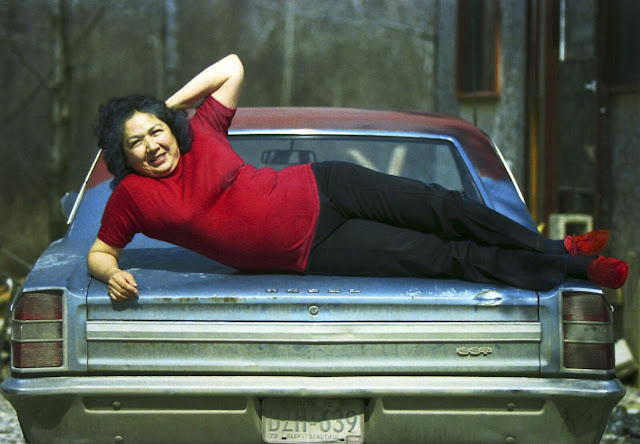 |
As We See It. By Suzanne Newman Fricke.
|
Conversations with Native American Photographers
Edited by Suzanne Newman Fricke
University of New Mexico Press, Albuquerque, NM, 2023. 224 pp.
Some years ago, I reviewed a book by James C. Faris titled Navajo and Photography: A Critical History of the Representation of an American People (University of New Mexico Press, 1996). Over 392 pages it deeply considers photography’s role in exposing and commandeering culture. According to the publisher, Faris “calls attention to the inability of most photography to communicate the lived experiences of native people or their history.” I remember being enthralled by the book and surprised at the author’s revelations.
I also recall thinking that, despite all the academic, linguistic, and ethical exegesis, Faris seemed motivated by something fairly simple — a sense of indignity, a personal wound of sorts that he suffered at someone’s hands in relation to or on behalf of Navajo peoples. (He even cautioned against using the word “the” in conjunction with “Navajo” for fear of inappropriately objectifying or drawing a collective conclusion.) I wished that, in addition to all of the well-reasoned third person argumentation, Faris could have said, “listen, here’s why I am writing about this topic.” Breaking the fourth wall, as narrative theorists would say, because there was something so distanced about his writing despite what could only be construed as passion for the topic.
This bit of personal/intellectual friction revisited me as I read Suzanne Newman Fricke’s As We See It: Conversations with Native American Photographers. Fricke interviews and generates illuminating copy about ten Native American photographic artists, with an additional chapter about a non-Native photographic influence. (More on that in a minute.) The organizing principle of the book is that of a primer, an introduction to contemporary Indigenous photographers, and how they address their personal experiences through their art. Fundamental and useful stuff for those who appreciate a glimpse of “lived experience” as filtered through art.
 |
| Wendy Red Star, Fall, 2006 |
My own Faris moment here has to do with the photograph on the cover of the book. It’s a 2013 wet plate portrait by William Wilson (born 1969, eight years younger than I am) titled Will Wilson, Citizen of the Navajo Nation, Trans-Customary Diné Artist. Wilson’s incongruous white-glove treatment of an SLR camera seems to me to symbolize the care-taking attitude assumed throughout the text toward photography as a phenomenon. (Upon further consideration I realize that the latex gloves he’s wearing are probably those of someone who has recently been pouring a wet plate. Still, there’s a cradling quality to the gesture that I find peculiar.) I am drawn to his circumstances in ways that are distinct from how others may respond.
Back to the studium of the present volume. What strikes me is a big question about the “it” of the book’s title. Was the implication that “we,” Fricke and her ten artists, are using cameras to weigh and assess Native American life? Or is something else being seen and articulated by this assemblage? My surmise is that “it” refers to the practice of photography in general, and by specific extension within the topic area of American Indian life.
 |
| Shelley Niro, Memories of Flight, 2011 |
This is where the ghostly presence arises to qualify the entire argument. Edward S. Curtis, to be precise, is the centenarian, white elephant in this room. The position feels obligatory, like we can’t have a book about photography and Native Americans without addressing the problematic Curtis enterprise. The chapter is the last piece in the book, the last word, and it leaves an acidic taste. As Fricke puts it, “perhaps someday, writers, art historians, curators and other scholars will be able to discuss Native American photography without first referencing Edward Sheriff Curtis...[Nonetheless] it is clear that today is not that day.” Well, maybe it is.
 |
| Tom Jones, Shades of Red, 2008 |
Curtis is a flagrant example of early 20th century attitudes toward indigenous peoples, yes. But does your entry-level reader need to emerge from an enlightening volume like this with Curtis’ darkcloth weighing on their head? There are ten contemporary photographers that one might become fascinated by and study further. The considerable value of this book lies in the words of the artists edited from interviews with Fricke, the ample bibliographies for further study, and the tantalizing handful of illustrations.
In her section about Jamison Chās Banks, Fricke observes that his “work highlights the fluidity in who is the enemy and who is the ally, positions that are relative and constantly changing.” I think this is a crucial frame for seeing the ten dynamic contemporary artists and the one enduring adversary here. Allow yourself to see “it,” that untethered pronoun, for yourself.
Purchase Book
Read More Book Reviews
 |
| Shelley Niro, The Rebel, 1987 |
 |
| Wendy Red Star, Stirs Up the Dust, 2011 |
 |
| Shelley Niro, La Pietà 3: Sorrow, 2004 |
 George Slade, aka re:photographica, is a writer and photography historian based in Minnesota's Twin Cities. He is also the founder and director of the non-profit organization TC Photo. georgeslade.photo/
George Slade, aka re:photographica, is a writer and photography historian based in Minnesota's Twin Cities. He is also the founder and director of the non-profit organization TC Photo. georgeslade.photo/Image c/o Randall Slavin








